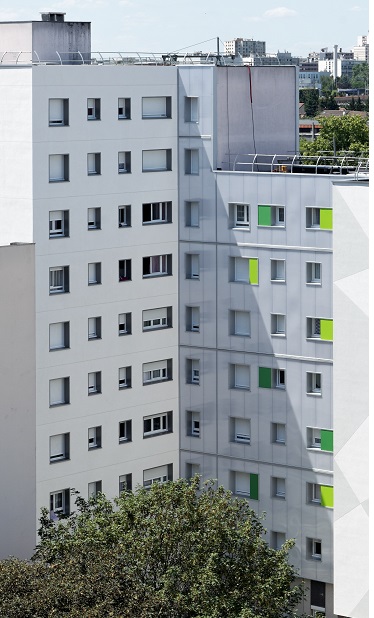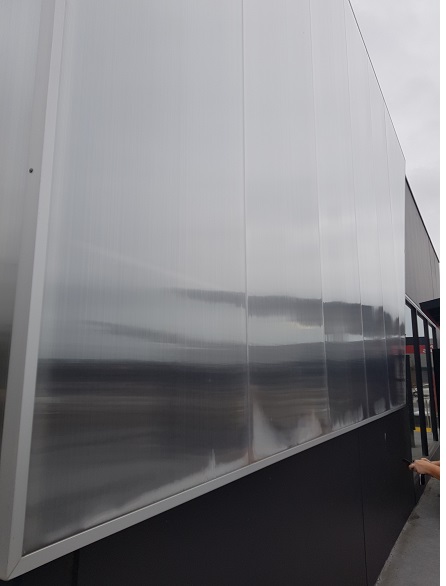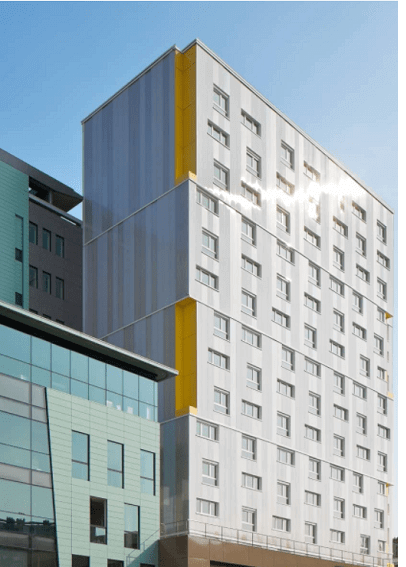A building leads a double life, one on the outside, seen by the public, and the other on the inside. Passersby notice the exterior of a building as the roof and other outside aspects that are in full view. But when it comes to the inside of a building, it’s a little different.
It’s easy for occupants to observe when the carpeting is worn or the floors need to be washed and buffed, but who notices whether or not insulation has been compromised by weather? That hidden life of a building can be a deciding factor determining the structure’s health and wellbeing. That’s why rainscreen cladding, which creates a defensive barrier to keep external weather from penetrating a building’s interior, is an excellent way to give the structure the protection that it needs.
DANPAL’S SUPERIOR RAINSCREEN CLADDING
Weather is a mighty opponent for a building to face. While we notice, on a day-to-day basis, whether we’re dealing with warm weather or cold, we don’t always pay attention to the consequences of the weather forecast.
That’s why Danpal’s Ventilated Rainscreen Cladding SYSTEM (VRS) is regarded as one of the best ways to protect a building’s interior from the external elements that strike with such force. VRS has double-notched panels that prevent rain and snow from penetrating the building; this keeps moisture from getting inside.
In addition, VRS provides natural ventilation thanks to an air gap that keeps insulation free from moisture. Another asset of VRS is the ease of installation; connections can be made right onto the support. No additional structural support is needed. Another time-saving feature is the fact that rainscreen cladding doesn’t require periodic service or even a lot of maintenance.
 USER FRIENDLY RAINSCREEN CLADDING
USER FRIENDLY RAINSCREEN CLADDING
In addition to the ease of installation, rainscreen cladding by Danpal offers a versatility that adds to appeal of the product. Rainscreen cladding delights architects because it can be made out of various different materials, including galvanized steel, aluminum, plastic, wood, brick, and imitation stone. Architects don’t like to be confined when designing a structure and that’s why Danpal products are a favorite for the profession.
Why should a building be limited in options? Danpal’s aim is to provide an architect with as many tools as possible, and nothing is more vital than unleashed creativity.
RAINSCREEN CLADDING IS THE HEALTHIER OPTION
Insulation is often ignored by a building’s occupants, and yet it’s key to maintaining a healthy living and working place for occupants.
If moisture invades a building’s interior and the insulation gets damp as a result, it won’t be long before mold develops. Mold thrives in a damp environment and then it spreads. Before long, the occupants of the building, particularly those who may suffer from respiratory ailments, may find their health is affected by their physical environment.
People who already have asthma or allergies are especially vulnerable to the harmful effects of mold. Rainscreen cladding doesn’t just protect buildings; it also protects the people inside them by preventing mold from developing.

 For modern glazing to be effective and of useful purpose, the material of choice needs to provide us with the following 11 attributes:
For modern glazing to be effective and of useful purpose, the material of choice needs to provide us with the following 11 attributes:


 RAINSCREEN CLADDING BY DANPAL
RAINSCREEN CLADDING BY DANPAL RAINSCREEN CLADDING BY DANPAL
RAINSCREEN CLADDING BY DANPAL How Rainscreen Cladding Works
How Rainscreen Cladding Works How Rainscreen Cladding Protects Your Insulation
How Rainscreen Cladding Protects Your Insulation How Wall Cladding Protects Insulation From Moisture
How Wall Cladding Protects Insulation From Moisture The Role Of Rainscreen Cladding
The Role Of Rainscreen Cladding Wall Cladding Protects Insulation
Wall Cladding Protects Insulation
 The Protection of Rainscreen Cladding
The Protection of Rainscreen Cladding
 This concept was developed through the ethos of Grimshaw’s architectural practice; strong conceptual legibility, innovation and a rigorous approach to detailing, all underpinned by the principles of humane, enduring and sustainable design.
This concept was developed through the ethos of Grimshaw’s architectural practice; strong conceptual legibility, innovation and a rigorous approach to detailing, all underpinned by the principles of humane, enduring and sustainable design. There was always something exciting about creating your own cubby house as a kid. Whether stacking cushions from the family sofa, draping bed sheets over the ironing board or arranging cardboard boxes to form enclosures, it allowed a sense of freedom to create and play, to be the master of one’s own universe.
There was always something exciting about creating your own cubby house as a kid. Whether stacking cushions from the family sofa, draping bed sheets over the ironing board or arranging cardboard boxes to form enclosures, it allowed a sense of freedom to create and play, to be the master of one’s own universe. What is the DANPAL® Ventilated Rainscreen System?
What is the DANPAL® Ventilated Rainscreen System? We hope this information will encourage more people to try our products this year. At the end of the day, if people plan to build a new construct or replace cladding, they need to choose a premium solution.
We hope this information will encourage more people to try our products this year. At the end of the day, if people plan to build a new construct or replace cladding, they need to choose a premium solution. In the past,
In the past,  The
The  Our light but solid
Our light but solid  This is why it is much easier utilizing an integrated system that combines all of your needs into one thing, rather than trying to piece different aspects of regulations together from multiple sources.
This is why it is much easier utilizing an integrated system that combines all of your needs into one thing, rather than trying to piece different aspects of regulations together from multiple sources. If you did not use rainscreen cladding on the exterior of a building, those materials that are porous and have been used in the construction process will be exposed to the negative weather conditions which will greatly accelerate the deterioration process of the structure.
If you did not use rainscreen cladding on the exterior of a building, those materials that are porous and have been used in the construction process will be exposed to the negative weather conditions which will greatly accelerate the deterioration process of the structure. Porosity is the ratio for the volume of the voids (openings) with the total volume of the material. Basically what this ratio represents is the storage capacity that the material has.
Porosity is the ratio for the volume of the voids (openings) with the total volume of the material. Basically what this ratio represents is the storage capacity that the material has. The decision on what type of wall
The decision on what type of wall  When it comes to Danpal and wall cladding, they are one of the leading providers in the industry. We have already talked about the important protective features that wall cladding provides, but with Danpal’s special system, it will also save you money in the long run, as the
When it comes to Danpal and wall cladding, they are one of the leading providers in the industry. We have already talked about the important protective features that wall cladding provides, but with Danpal’s special system, it will also save you money in the long run, as the  Danpal is one of the leading figures when it comes to rainscreen cladding. The Ventilated Rainscreen System is light but extremely solid. This is thanks to the material it is made out of – connector-bound Microcell polycarbonate panels which are as much as three times lighter than the mainstream rainscreen cladding that is found on the market today.
Danpal is one of the leading figures when it comes to rainscreen cladding. The Ventilated Rainscreen System is light but extremely solid. This is thanks to the material it is made out of – connector-bound Microcell polycarbonate panels which are as much as three times lighter than the mainstream rainscreen cladding that is found on the market today.